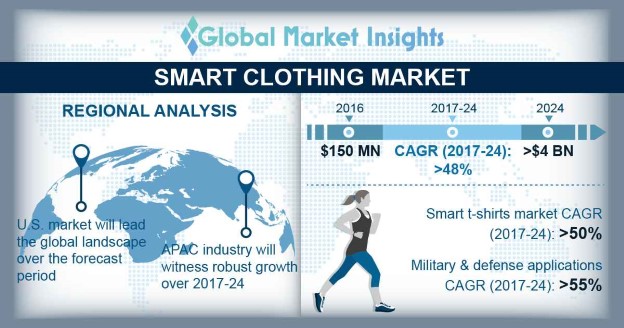Smart clothing market to accumulate heavy returns via military applications over 2017-2024, U.S. to majorly drive the regional landscape
Publisher : Fractovia | Published Date : 2017-09-06Request Sample
The rapidly changing trends in the fashion cosmos is one of most pivotal factors impacting the growth of smart clothing market. With the progressive fads prevalent in apparel design and technology, key companies partaking in smart clothing industry share are expected to introduce unique, innovative products such as 3D-printed jackets, smart coats, connected clothes, and belts with fitness tracking. For instance, in 2017, Polar, a key player across wearable sensors industry, has launched a polar team pro shirt, that helps in heart rate monitoring and GPS tracking. Athletes have used this new smart clothing brand to determine the distance & acceleration and improve their performance. Citing yet another instance of product innovation, DuPont, a products & services firm, introduced a new kind of stretchable electronics ink and films for smart apparels along with its new product - Dupont Intexar smart clothing technology at the Outdoor Retailer Summer Market 2017, which may bring about a welcome change of dynamics in smart clothing market.
Germany Smart Clothing Market Share, By Product, 2016 (USD Billion)

In July 2017, OMsignal, a key manufacturer of bio-sensing apparels and smart textiles, introduced the OMbra that measures heart rate and breathing. Other key players across smart clothing industry are developing smart apparels that can detect respiratory illness and monitor patients with chronic conditions such as asthma. Xenoma, a famous participant in the smart clothing market, have incorporated virtual reality and artificial intelligence technology in its camera free-skin shirts to measure the sport & exercise activity levels in an individual. The introduction of new products such as fabrics flooded with light and temperature sensitive clothing has complemented the product portfolio expansion of smart clothing industry, thereby helping to create value in the smart apparel space.
It is to be noted that strategic collaborations and joint ventures will continue to play a major role in influencing smart clothing market trends. Google Incorporation and Levi Straus & company, a U.S. based clothing firm, have collaborated recently for the Jacquard smart jacket venture – a denim jacket that can connect to a paired smartphone. The smart apparel, intended for cyclists, enables the wearers to connect with smartphone services such as music or maps directly via the jacket sleeve and also helps them control the smartphone experience. These connected clothes are expected to find tremendous applications even across the fashion and healthcare industries, pertaining to their ability to interact with other equipment & services and adapt to any kind of environment.
According to the IDC (International Data Corporation), emerging smart clothing industry is forecast to leverage the wearable technology market revenue. As per its reports, smart apparel shipments are forecast to rise from 3.3 million in 2017, in terms of volume, to 21.6 million by 2021 with a stupendous CAGR of nearly 76% over 2017-2021. This growth will undoubtedly have a pivotal influence on smart clothing market, cite experts.
The geographical scope of smart clothing industry is proportionately segmented across North America, Europe, and Asia Pacific. The U.S. has always been at the forefront as far as sporting events across the globe are considered. The country has given birth to world class sportspersons excelling at numerous world championships, a trend which it seems to be intent on continuing, that will undoubtedly propel the regional smart clothing industry. Additionally, sports clubs across the U.S. are collaborating with the firms in the smart clothing market to improve the performance of their sportspersons and avoid sports injuries, thereby augmenting the regional expansion further.
Smart clothing market across China and India is expected to gain traction with the growing requirement of protective clothing for military & defense personnel. In addition, the escalated popularity of wearable equipment with newly embedded features is another factor that is forecast to create profitable avenues for smart clothing industry players across the Asia Pacific region.
Smart clothing industry may experience slight obstacles in the forthcoming years, subject to a couple of crucial factors, namely, surging product costs and low awareness levels among the consumers pertaining to the product applications. Furthermore, the fact that these wearables have been decoded as ‘smart’ makes them vulnerable to technical glitches such as sensor imprecision and breach of data. However, smart clothing industry companies have been attempting to meet these challenges head-on, and efforts are being made by the manufacturers to eliminate the existing constraints by introduction authentic, highly efficient products in the market.
In spite of a considerable spectrum of shortcomings, smart clothing industry is forecast to sketch a favorable growth diagram in the years ahead. As per the research analysts, smart clothing market is predicted to surpass a targeted revenue margin of USD 4 billion by 2024, having garnered a revenue of USD 150 million in 2016. This revenue cumulation undoubtedly stands as a vital testimony to the surging growth map of smart clothing market.